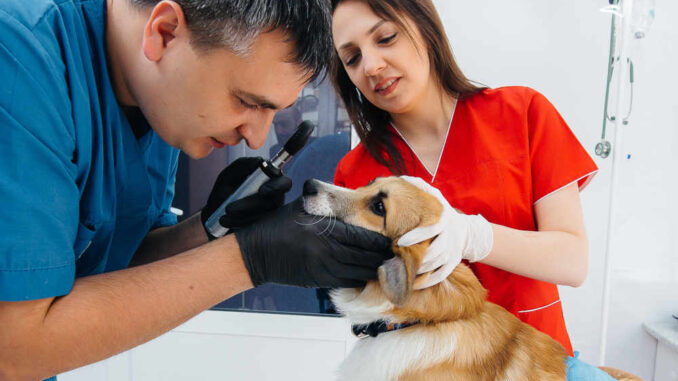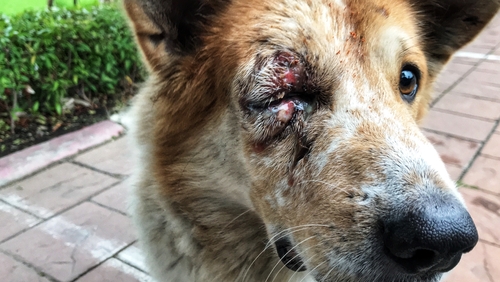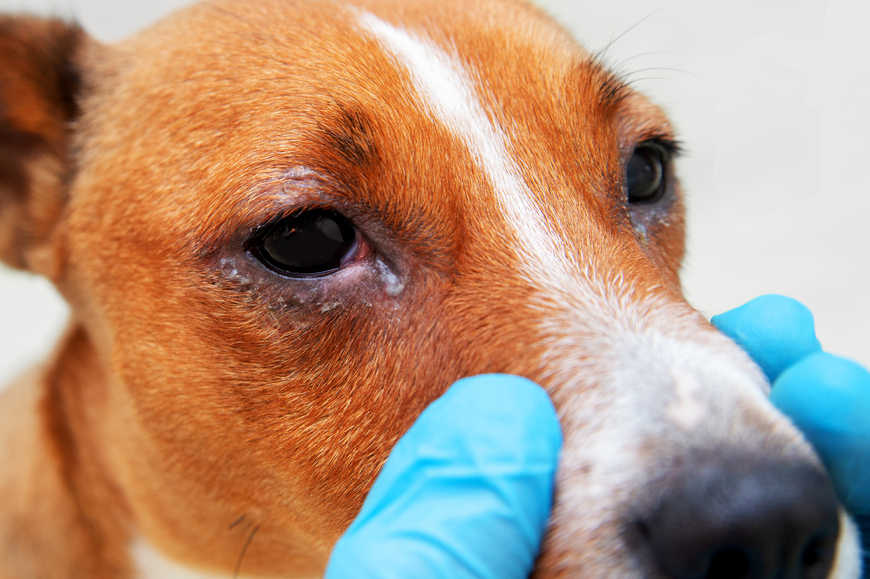
This article was updated on March 5th, 2023
Seeing blood in your dog’s eye is can be quite alarming, to say the least. While blood in the eye, or hyphemia, isn’t a disease itself, it is a sign of troubles in the eye as well as other parts of the body. With this in mind, it’s no wonder that blood in a dog’s eyes is something veterinarians encounter very commonly and take very seriously.
Issues that May Cause Blood in a Dog’s Eye
When you see blood in a dog’s eye, the issue can be directly with the eye itself or with something systemically elsewhere in their body that affects the blood vessels or makeup of the eye. It can definitely be hard to tell where the blood in a dog’s eye is coming from, so it’s always important to involve your veterinarian anytime you see anything off with your dog’s eye, including seeing blood.
Causes of Blood in a Dog’s Eyes
Dog eyes have a lot of protective mechanisms in place, but unfortunately, they aren’t indestructible. Here are some things that directly affect a dog’s eyes that can cause blood.
Eye Injury
Bites, bumps, pokes, scrapes, foreign bodies, and other types of trauma can cause blood in a dog’s eyes. Of all the things that a dog encounters in a day, there are many that may harm their eyes. Any of these may lead to a rupture of a blood vessel that allows blood into the eye. They may also have swelling, bruising and other lacerations around the eye. These types of injuries should be seen by a vet as soon as possible.

Retinal Detachment
The retina is the lining on the back of the eye that converts the light you see into signals that are sent to your brain to process into images. It’s an important part of an eye’s function. Sometimes it can become detached from the eye which can lead to bleeding and blood in the eye. This detachment can occur following trauma, from high blood pressure, autoimmune disease, inflammation, abnormalities with the eye, or for unknown reasons. Dogs with a detached retina may have difficulty seeing. Depending on the severity, no treatment may be required or surgery may be needed to reattach the retina. Click here to view a picture of retinal detachment from CliniciansBrief.com or read their article about retinal detachment.
Uveitis
Uveitis is inflammation of the inner parts of the eye. It can be brought on by infections, high blood pressure, toxins, trauma, and tumors. When severe, it can even lead to bleeding within the eye. It is very painful and a dog will often hold the eye closed or squint. They will also have lots of watering and tearing. Most cases of uveitis can be treated by getting rid of the underlying cause and reducing the pain and inflammation with eye drops. Click here to see a picture from EyeCareforAnimals.com.
Eye Tumors
Tumors, whether cancerous or benign, can interfere with the normal function of the eye. Some of those tumors can block the movement of fluid, change the shape of the eye, or affect blood supply causing bleeding. Some tumors can actually be seen in the eye while others will require special imaging. Tumors may be removed by a veterinary ophthalmologist or require removal of the entire eye. Click here to see a picture from IndyAnimalClinic.com or read their page about uveal melanoma.
An issue anywhere in the body can also lead to blood in the eye. These are generally accompanied by other signs as well.
Hypertension (High Blood Pressure)
As humans, we’re well aware of the effects that high blood pressure can have. The same effects are true for dogs. One of those effects can be increased pressures that actually causes rupture of blood vessels in the eye. It may also lead to blindness, nose bleeds, depression, paralysis, and disorientation. Your vet will need to check your dog’s blood pressure and treat the underlying cause, such as kidney disease, heart disease or diabetes. Click here to see a picture from CriticalCareDVM.com.
Vasculitis
Since blood is housed in blood vessels anywhere you are in the body, including the eye, anything that affects those blood vessels can cause blood in a dog’s eye. Vasculitis, or inflammation of the blood vessels, can cause bleeding into the eye. This inflammation may stem from an infection, autoimmune reaction, allergy, medication reaction, or cancer. Not only might there be blood in the eye, you may also see bruising of the skin, nose bleeds, swelling, hives, hair loss, and sores. Your vet will need to determine the underlying cause of the vasculitis and get it under control.
Others
Hypothyroidism, blood clotting abnormalities, eye anomalies, deficiencies, and parasites are other possible causes of blood in a dog’s eye. They will be accompanied by various other signs depending on the issue and all require a vet’s diagnosis and treatment.
Just as a note here, conjunctivitis, or pink eye, can cause redness of the white part of the eye that may look similar to blood in the eye but is often a less serious issue.

Other Signs to Watch Out for With Blood in Dogs’ Eyes
Since blood in a dog’s eyes can show up for reasons that aren’t directly related to the eye, you’ll probably notice some other signs as well. Your dog may be a little off their game and not want to eat, feel a little lethargic, or you may notice other bumps, bruises or bleeding. They may be drinking more, losing or gaining weight, or you may see lumps in the eye. The eye may be very painful and they may squint or have excessive tearing. Seeing anything along these lines along with blood in the eye should warrant a veterinary visit.
When to See a Vet for Blood in Dogs’ Eyes
You don’t want to mess around with blood in dogs’ eyes. Things can go from bad to worse pretty quickly depending on the cause. As we discussed, blood in the eye can come from issues with the eye itself or from something elsewhere in the body going wrong. Either way, you risk permanent damage to the eye or other major problems if you don’t get the issue under control.
What Will the Vet Do For Blood in Dogs’ Eyes and How Much Will it Cost?
Diagnosis
Your vet is going to want to start with a thorough exam, including the eye. They may dilate the pupil and use an ophthalmoscope to examine the inside of the eye. This will let them check for tumors, retinal detachment, abnormalities, or to try to see where the blood is coming from.
They may also run blood work to check organ function, blood cell numbers, clotting ability, and hormone levels. Blood pressure may be tested, and imaging may be needed as well. If your pup has an injury that is causing the problem, they will be checked for other areas of pain and swelling as well.
Treatment
Once the vet finds out what is causing the blood in your dog’s eye, they can start treatment. This is going to include a wide range of things depending on the diagnosis. Some of those may be treating high blood pressure with medications, kidney disease or diabetes with a diet change and medications, or hypothyroidism with medications.
Injuries will need to be treated with anti-inflammatories and antibiotics. Vasculitis and uveitis will need to be treated with either systemic or localized anti-inflammatories. Eye tumors and detached retinas may require surgery to remove or repair.
In some cases of blood in a dog’s eye, removing the eye may be the best option.
Cost
Since there are so many possible causes and treatments of blood in a dog’s eye, there is also a wide range of costs associated. Diagnosis may be as simple as looking at your dog’s eye and costing around $50, or it could involve multiple blood tests and imaging, costing you more around $200-$300.
Treatment may be as easy as medicated eye drops that cost $25, or a surgery by a veterinary ophthalmologist to remove a tumor that costs $2,000 or more. For most eye injuries, look to pay around $100-$200, while systemic causes may be more expensive with the potential for lifelong medications.
How to Prepare for the Veterinary Visit
Your vet is going to want to know as much as about the history of your dog as possible. They’ll ask you when you noticed the blood, if you’ve seen any other signs, and how your dog has been acting. Taking pictures of the eye can be helpful, especially if you’re seeing changes in it. For example, if there is more or less blood than when you first noticed it, try to document that.
Also, once the diagnosis is made, be sure that you understand what condition your dog is dealing with. Some of these causes might require lifelong medications or lifestyle changes that you’ll need to be onboard with. Some of these conditions can also be very serious, so have your vet give you a prognosis, if possible.
Is There Anything I Can Do at Home to Help My Blood in My Dog’s Eyes?
If you truly see blood inside your dog’s eyes, don’t hesitate to see your vet. Again, the causes of this can lead to serious damage to the eye or other areas of the body if not treated. If you see redness or cloudiness to the surface of the eye, don’t hesitate to see your vet. Corneal ulcers or abrasions can also become very serious without treatment.
If you notice redness or swelling of the tissues around the eye, you may be looking at a cause of pink eye and, if mild, you may choose to monitor it. Try flushing the eye with a sterile saline solution and apply an ice pack to see if the redness and swelling get better. If not, or if your dog is particularly painful, see your vet.
Disclaimer: This website's content is not a substitute for veterinary care. Always consult with your veterinarian for healthcare decisions. Read More.


Be the first to comment